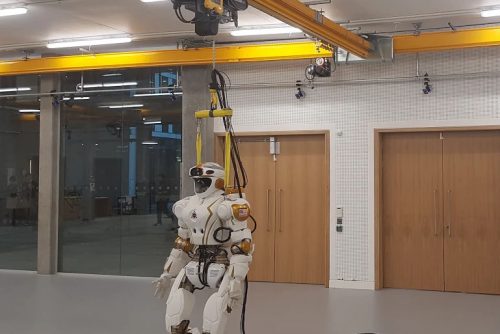Engineer creates safety solution for futuristic robotics project

A Wirral engineer has created a specialist support system for trials of a futuristic robotics project.
Hoist UK designed, manufactured and fitted the support system for the Valkyrie robot project at The University of Edinburgh’s Advanced Robotics Department.
Valkyrie is one of the most advanced humanoid robots in the world, standing 1.8 meters tall, weighing 125kg, with 44 separate joints to co-ordinate balance and movement.
Topping this all off it comes with with a price tag of more than £1m, which highlights the need for a secure support system.
Built by NASA in 2015 and brought to the University of Edinburgh in 2016, Valkyrie is designed to push the boundaries of how humans and robots can work together, work in disaster areas where people can’t go and, eventually build habitats on Mars.
Programming an advanced piece of technology like Valkyrie to perform basic tasks such as walking and balancing is exceptionally challenging.
Aware of the amount of trial and error involved in programming her, the robotics department at the university approached Hoist UK to provide a safety solution.
The university robotics department wanted a system that would allow multiple trial and error movements and balancing tests for Valkyrie.
This would prevent her falling to the floor, causing damage to an irreplaceable robot.
Based on the requirements provided by the university, the Hoist UK team designed, tested and installed a radio-controlled Double Girder Rigid Crane System.
A chain hoist was fitted to the 6.5 metre span bridge.
The bridge and the hoist were both rated with a safe working load of 500kg – four times the weight of Valkyrie.
The robot was to be hung from the hoist to allow her to stay upright whenever a movement test failure would cause her to fall.
Two radio-controlled motorised crane bridges were fitted to the runways, one for immediate use, the second added to accommodate future expansions of the project.
The motorised system would move independently of Valkyrie, allowing her the ability to move safely throughout the room.
The radio controller would allow the operator the ability to move the hoist, giving Valkyrie free movement in the working area, from a safe distance.
The system was installed onto the underside of the laboratory’s existing concrete ceiling.
Paul Jordan director at Hoist UK, said: “Being a part of a programme that will one day lead to people travelling to Mars was very exciting.
“Our team really enjoyed building a relationship with the robotics department at The University of Edinburgh and we’re very proud of the work we’ve done here and excited to see what becomes of it in the future.”
The importance of the project was emphasised by Vladimir Ivan, from The University of Edinburgh, who said: “Working with the Valkyrie robot is not a case of, if she falls down, it’s when.
“We are pushing the robots to their limits in a controlled environment so that they are safer and more robust when they get deployed outside of the lab.
“Hoist UK helped provide a valuable safety solution to allow our ongoing testing with the robot in a safe environment.
“We’re really pleased with the result and look forward to working with Hoist UK in the future when we expand the programme further.”







